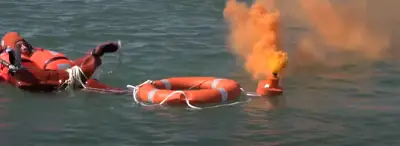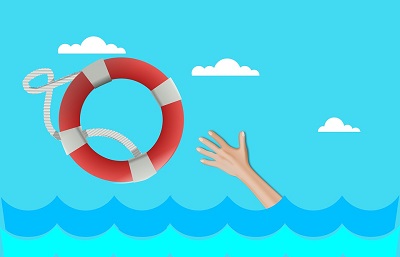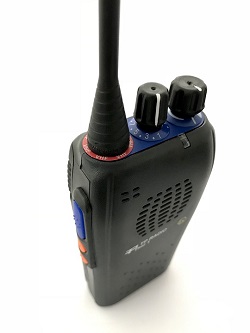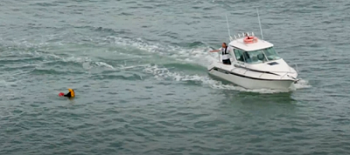If a passenger on your boat falls overboard what should you do first? First of all, stop/reduce the boat engine. If the victim is not wearing a lifejacket, toss a PFD. Next, send distress signals nearby.
So you’re cruising on your boat, listening to some tunes, and enjoying the water. Suddenly, a passenger falls overboard. What should you do first?
Well first of all don’t panic. If you have a life vest then throw it in their direction so they can grab it before they go too far out into the water. You also want to quickly turn around so that there’s less distance between them and your boat. As soon as they grab onto the side of your boat or climb back onboard, call for help if necessary. And finally, steer away from any obstacles that may cause damage to both people or property while bringing them back safely to shore.

A passenger on your boat falls overboard what should you do first?
Throw PFD to an overboard victim
Toss them a throwable type PFD instead of throwing them the other one they are swimming for. A throwable will allow you to pull them back alongside your boat and then someone can reach down and grab it as opposed to having to dive in after it.

Getting tossed the correct PFD could save their lives, so make sure this happens correctly. A throwable PFD, the orange or yellow lifebuoy, is much larger and harder to miss than the traditional wear-it-at-all-times PFD that floats on top of the water.
Send distress signal
Alert everyone immediately of the situation at hand and ask them to call for help. A nearby fishing boat or rescue personnel should always be called immediately in case someone needs to be rescued from the water and they need all the help they can get.

Use VHF channel 16 to call for help. Call out “mayday-mayday-mayday” three times and give all necessary information. A description of the incident should be given along with your name/location, how many people are in the water, their condition, and any other pertinent information that may assist the rescue team in locating you or sending a boat out to help.
Use MOB button
A MOB button is a great tool to have on your boat if you are traveling near any waterways. A MOB button is actually a really simple system to use and will help notify rescuers the moment someone goes overboard. A MOB can be installed on any boat, even if it’s an older model so long as there is access to its wiring. A GPS will help you stay on track so that you can keep an accurate record of the location where your passenger went overboard. Also be sure to note down any obstacles nearby like rocks, docks, and other boats.
Apply speed and/or course
Reduce speed immediately once a passenger goes overboard. A slow boat can help rescuers locate him/her easier and it also reduces the chance of the person falling into a wake. Turn the boat’s bow towards the person in the water so you can approach them from the same side they went overboard.
Approach carefully
When deciding on how to approach the person in the water you must decide whether it’s safer to turn your boat downwind or into the current. A strong current could be dragging the victim underwater and it can be hard for rescuers to locate them. A downwind approach will allow you to still stay in one place while trying to keep the person in your boat’s sight. A downwind approach will also give shelter to the person who went overboard in the event of strong winds.
Post a lookout

Post a lookout or use someone as a lookout so that you don’t miss them in the water. A good option is to use a small binocular at the stern or remove your shades to get an even clearer view of your surroundings. A lookout can help you locate the missing passenger so that they can be brought back on board as soon as possible. Also, keep in mind that if the person is injured, then they may not be able to swim or keep their head above water for a long period of time. A speedy recovery could be life-saving in this situation.
Aware of running propeller
Stop the engine once you figure out the best way to approach the person in the water. A boat can run up on a victim very easily and cause severe injury or death. A running engine can also scare off a panicked individual and he/she will not stick around for help. You must do everything possible to make sure they know you’re there to help so turn the engine off and you can help calm the individual down. A calm person will be easier to rescue so try to keep them from freaking out any more than they already are.
Use buoyant lifebuoy
Use a buoyant heaving line or lifebuoy to pick them up if you don’t have a Reboarding device. A heaving line is a preferred way to bring someone back on board because it can be thrown from a further distance than most lifebuoys. A heaving line also has a clip on the end so that you can loop it around their arm or leg for easy retrieval. A lifebuoy is another alternative and can be used just like a heaving line. A lifebuoy will have the added benefit of keeping their head above water if they begin to drown. A drowning person might be too weak or injured to swim and could go under due to the weight of their clothing, so a buoyant lifebuoy is ideal for this situation.
If the person is too weak to grab onto the line or lifebuoy then send out a second person to help them. A second rescuer can grab onto the victim and pull them up to the boat. A second rescuer can also keep the victim’s head above water while you reach out with a heaving line or lifebuoy. Pull the person back on board over the stern of the boat.
Balance your boat
Keep your boat balanced or make sure there is a stable platform for the victim once he/she steps on board. A good option is to have an extra deckhand to help support the victim’s weight. A person who has fallen overboard will likely be weak and injured, so try not to make them stand on their own two feet for too long and keep them in a stable position. First aid treatment can be performed once the victim has been safely brought back on board the pleasure craft.
Conclusion
When a passenger falls overboard, you should call for help and quickly turn your boat back towards them. The first thing you should do is reduce your boat speed and toss him or her a personal floatation device (PFD). If he or she doesn’t wear one already, then give them yours. The next step is to turn around and slowly approach from downwind or into the sea whichever it stronger. Finally, stop your boat’s engine when close enough so that waves won’t be too big for the victim to stand up in between them if they’re not wearing a PFD. In conclusion, just remember these three steps every time somebody falls off of your boat.

